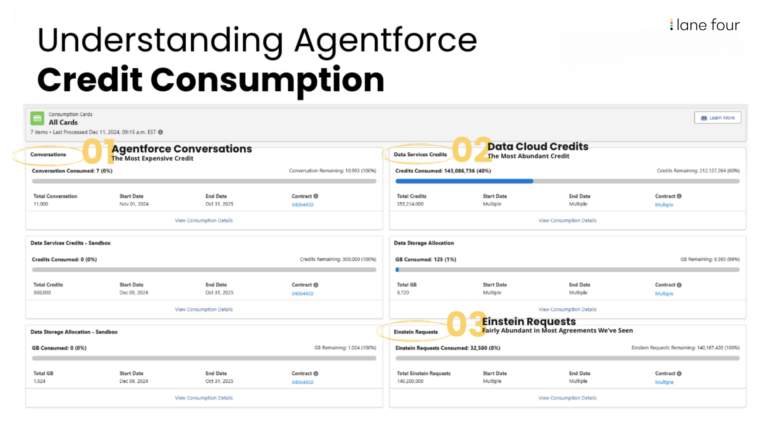Teams are beginning to realize the potential of integrating Agentforce into their go-to-market workflows—it’s fast becoming a valuable layer in modern Salesforce architecture. But when the conversation shifts to cost, there’s sometimes a disconnect and we’ve seen this a few times with our own customers.
Agentforce doesn’t follow the familiar SaaS model of predictable monthly or annual subscriptions, and it definitely doesn’t run on goodwill and server space. It’s metered. Every prompt, every interaction, and every automated task taps into a credit-based system. And those credits? Well, they can disappear faster than you’d expect, especially when AI is being used at scale. The consumption model feels invisible at first. Until it doesn’t.
So, what exactly are you paying for?
Think of credits like digital tokens that get eaten every time you interact with the AI in different ways. Right now, there are three big credit buckets to know about if you’re bringing Agentforce into your Salesforce org.

Conversation Credits
These are the heavy-hitters, being the most expensive credit type. One “conversation” means a full 24-hour exchange between a user (customer or employee) and your AI. It doesn’t matter if they send one message or twenty. Once that back-and-forth begins, you’re on the meter.
Why’s it pricey? Because this is where most of the magic happens—customer interactions, support resolutions, sales nudges, all that front-facing functionality that makes Agentforce shine. But it adds up fast. And that’s why you want your AI use to be doing something worthwhile; it’s either saving your agents’ time or driving new revenue, not just answering FAQs it could’ve pointed to in a knowledge base.
Data Cloud Credits
These credits are consumed whenever Agentforce uses Data Cloud; a common example would be the collection and storage of agent analytic data. Salesforce calculates credit consumption based on how Data Cloud is used and the amount of data that is processed. Businesses typically find that their service agreements include a respectable number of Data Cloud credits so this is usually not a significant extra cost.
Einstein Request Credits
Now this one surprises people. Every time your org calls on a large language model (LLM) such as asking Agentforce to summarize a case, draft a note, or generate content, you burn through Einstein Request credits. And since these tasks can happen multiple times per conversation, they stack quickly. Most agreements include a good number of Einstein Request credits, though they are typically not as plentiful as Data Cloud credits.

The reality is that no two orgs will burn through credits the same way. It depends on how your Agentforce flows are designed, how your users behave, and even how you’ve configured your automations.
A team that’s using Agentforce for customer triage and escalations will chew through conversation credits differently than one using it for sales coaching. So it’s not just about tracking consumption but rather about designing an Agentforce strategy with consumption in mind to begin with.
We’ve seen more than a few teams get hit with the jump scare here. The use cases for AI are obvious, the team’s excited about it, but the reality of consumption-based pricing tends to come in late. So here’s the key takeaway: before you roll out Agentforce and turn your team loose, get clear on how it’s being used and what it can actually deliver when it’s running with purpose and intention.
We’ve been building and refining tailored AI strategies across industries for the past eight months, and we know how to make AI pull its weight without burning through credits like it’s Monopoly money. So if you want the AI you’re excited about today to still make sense when the invoice lands next quarter, let’s chat.
